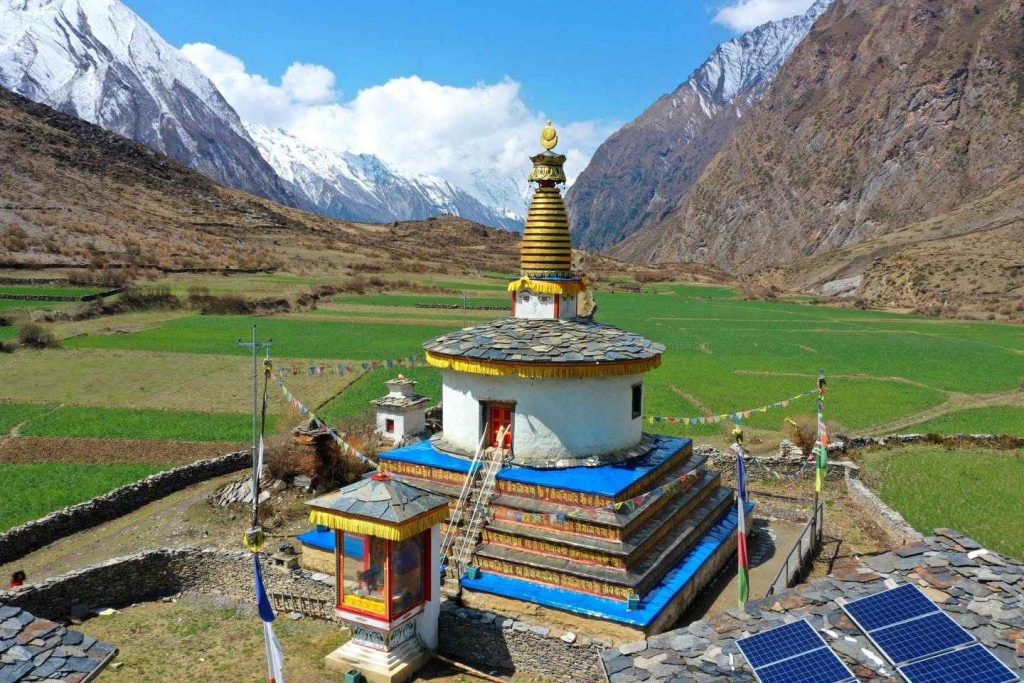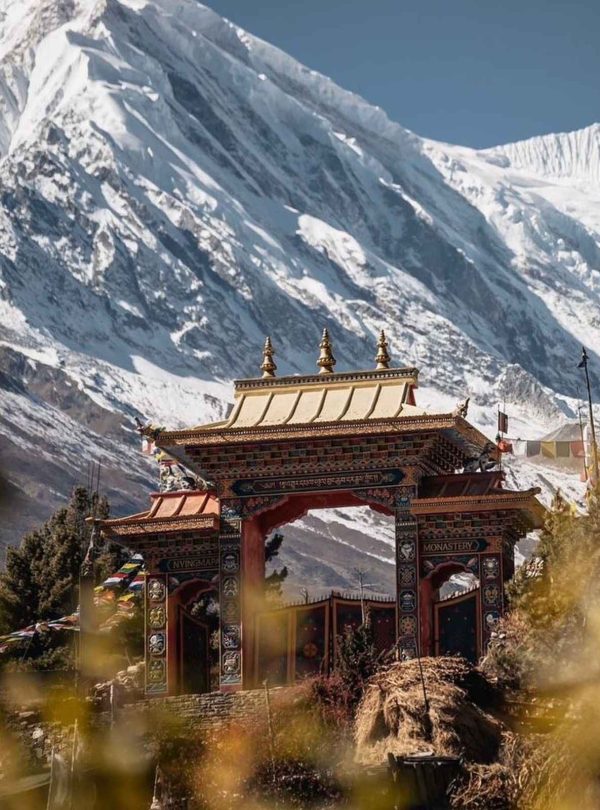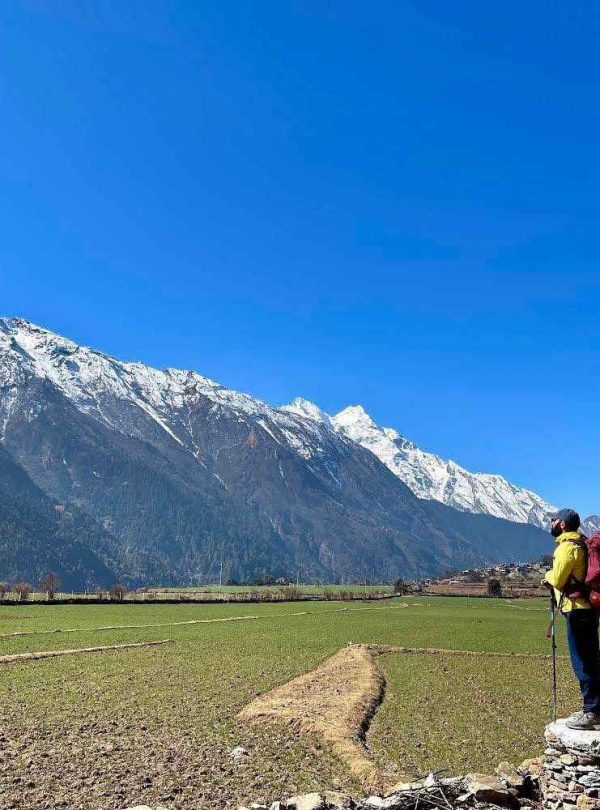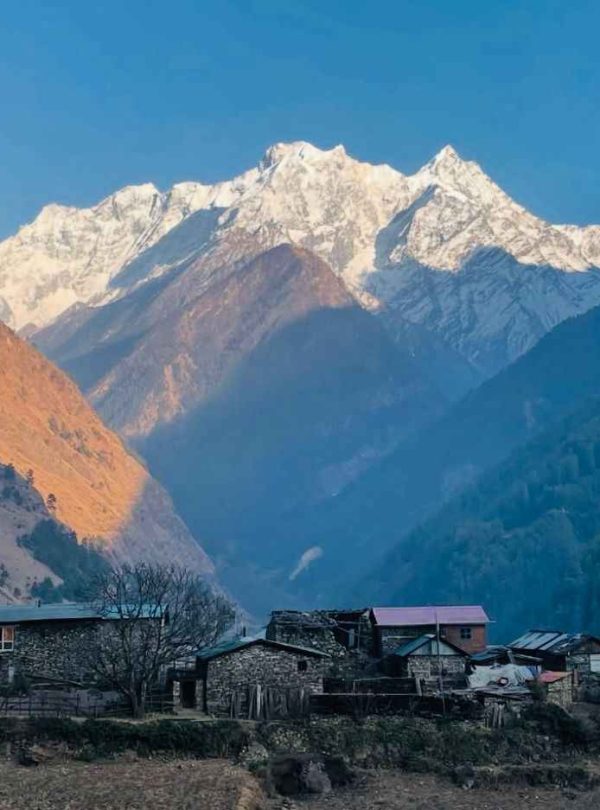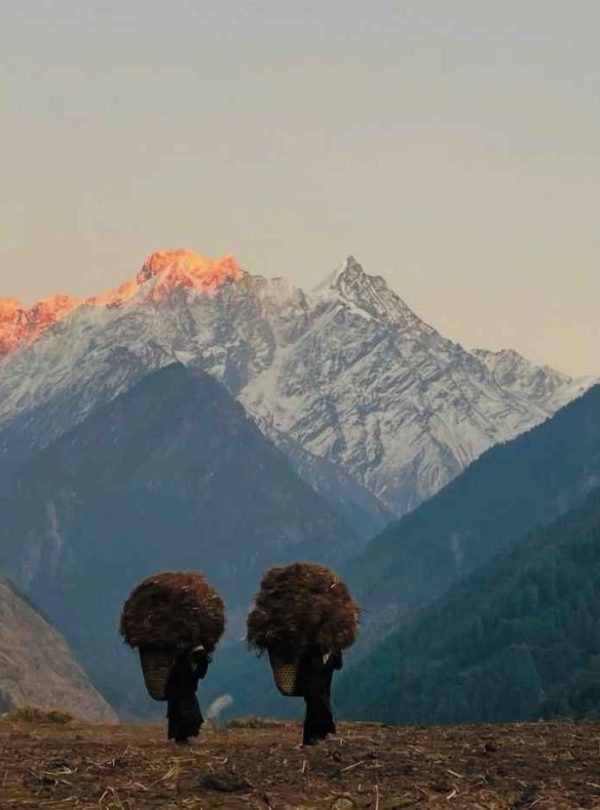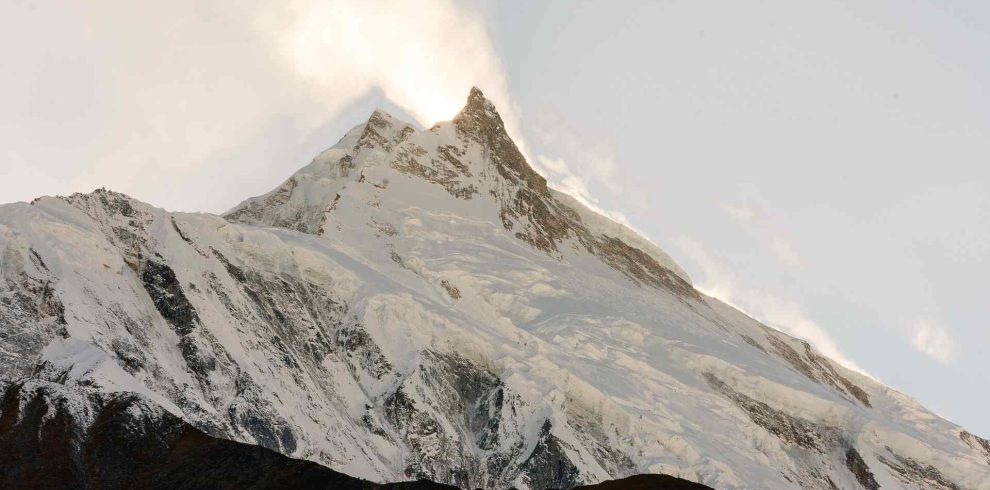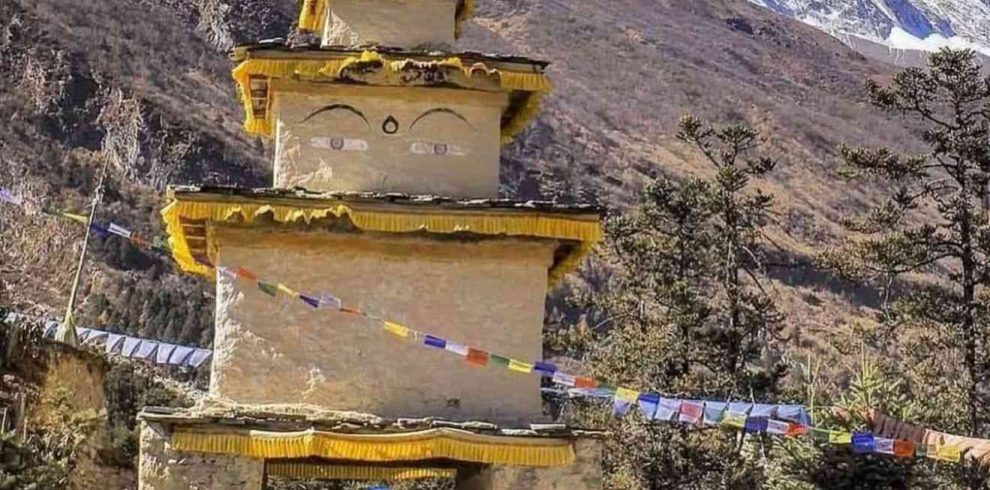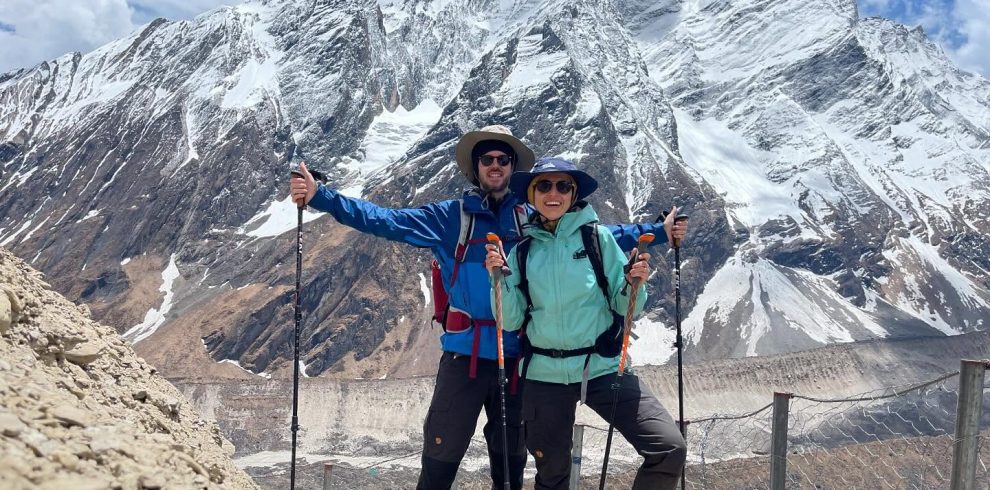The 23-day Tsum Valley & Manaslu Circuit Trek combines breathtaking Himalayan landscapes with the preserved Tibetan Buddhist culture of a hidden valley. This adventure takes you around Mount Manaslu and into the remote Tsum Valley, where ancient monasteries, prayer walls, and traditional villages offer a rare cultural immersion alongside high mountain passes and stunning views.
Tsum Valley & Manaslu Circuit Trek Overview
The Tsum Valley & Manaslu Circuit Trek is one of Nepal’s most rewarding adventures, combining untouched Himalayan wilderness with deep spiritual heritage. Located to the northeast of the Manaslu massif, the remote Tsum Valley was opened to trekkers only recently. Its isolation has preserved a rich Tibetan Buddhist culture. Along the trail you will see long mani walls carved with prayers, colorful prayer flags fluttering in the wind, and ancient monasteries such as Mu Gompa and Rachen Gompa, where centuries-old scriptures are still preserved.
When joined with the classic Manaslu Circuit, this journey becomes truly unforgettable. Trekkers circle the towering Mount Manaslu (8,163 m), cross the challenging Larkya La Pass (5,160 m), and explore hidden valleys filled with traditional villages and sacred temples. Unlike the more crowded Everest or Annapurna routes, this region offers an authentic off-the-beaten-path feel while still rewarding you with spectacular Himalayan views.
This carefully designed 23-day itinerary provides the right balance of adventure and safety. With enough acclimatization and rest days built in, you can fully enjoy both the natural beauty and the cultural highlights of the region. It is the ideal choice for adventure seekers who want a complete and meaningful trekking experience in Nepal.
Highlights of the Tsum Valley & Manaslu Circuit Trek
- Discover the remote Tsum Valley, rich in Tibetan Buddhist culture, monasteries, and sacred caves
- Trek around Mount Manaslu (8,163 m) with stunning views of Ganesh Himal, Himal Chuli, and Sringi Himal
- Cross the dramatic Larkya La Pass (5,160 m) for one of the best Himalayan panoramas
- Walk through diverse landscapes from lush forests and terraced fields to glaciers and alpine valleys
- Visit cultural landmarks like Mu Gompa, Rachen Gompa, and traditional Tsumba villages
- Enjoy a less crowded alternative to Everest and Annapurna with authentic off-the-beaten-path trails
- Travel safely with ample acclimatization days and support from experienced local guides and porters
Tsum Valley and Manaslu Circuit Trek 23 Days Detailed Itinerary
Your Himalayan journey begins as soon as you step off the plane at Tribhuvan International Airport in Kathmandu. The busy arrival hall is full of travellers, but outside, our representative is waiting to greet you with a smile and a traditional khada scarf. A short 30-minute drive through the colourful streets of Kathmandu brings you to Thamel, the lively heart of the city.
Thamel is alive with prayer flags, small temples, trekking shops, cafes, and the scent of incense. After checking in at your hotel, you can explore the narrow alleys at your own pace or relax after your long flight. Later in the evening, your trekking guide will meet you for a comprehensive briefing about the adventure, help you check your gear, and answer any questions you may have.
This first evening is a gentle introduction to the energy of Nepal. It allows you to settle in, adjust to the new atmosphere, and prepare for the great journey ahead.
The first full day begins with an early departure from Kathmandu. Leaving the busy capital behind, the road winds along the Trishuli River past rolling hills, roadside markets, and farming villages. The first few hours are on paved highway, but once you reach Arughat the smooth road gives way to a rougher track that follows the Budhi Gandaki River.
This drive is long, around eight to nine hours, but it is full of incredible scenery. You will see terraced fields carved into the hillsides, waterfalls tumbling down steep cliffs, and locals carrying heavy baskets of produce along narrow trails. Children wave at passing jeeps, and farmers tend to their crops as you pass by.
By late afternoon you arrive in Machhakhola, a small settlement beside the river whose name means “Fish River.” Here you get your first taste of rural mountain life. A simple tea house provides shelter and hot food to prepare you for tomorrow’s first walking day.
Your first real trekking day begins with the sound of the Budhi Gandaki River rushing beside you. The trail undulates along its banks, sometimes climbing over rocky ridges and sometimes dropping back to the water’s edge. You cross suspension bridges that sway gently under your feet, offering thrilling views down to the river below.
The walk passes through small villages like Khorlabesi and Dobhan, where locals smile and offer you tea. Along the way you will pass Tatopani, known for its natural hot springs, where steam rises from the rocks beside the trail. The vegetation shifts from lush subtropical forest to more open farmland as you climb steadily higher.
By late afternoon you reach Jagat, a beautiful stone paved village perched on a ridge. This is the official checkpoint for the Manaslu Conservation Area, where your permits are registered. Jagat feels timeless, with its traditional houses, mani walls, and children playing in the alleys. The sense of entering a restricted and sacred region begins here.
From Jagat the trail continues along the Budhi Gandaki, climbing through dense forest and bamboo groves. You pass through Philim, a larger village known for its school built with Japanese support. The path becomes narrower as you enter a dramatic gorge where waterfalls drop from cliffs above.
At Ekle Bhatti the trail divides. The left path continues along the Manaslu Circuit, while the right path climbs steeply toward the sacred Tsum Valley. You follow the latter, gradually ascending through pine forest where the air feels cooler and fresher.
By evening you arrive in Lokpa, the first village in Tsum Valley. Lokpa is a quiet settlement surrounded by forest, prayer flags, and distant views of snow capped peaks. You will notice an immediate change in atmosphere. This valley is more remote, more spiritual, and less touched by modern development. Tonight you rest at a tea house where silence and mountain air set the tone for the days ahead.
Leaving Lokpa, the trail descends through forest filled with pine, rhododendron, and moss covered rocks. A long suspension bridge crosses the Shiar Khola, whose water is crystal clear and fast flowing. On the far side, the path climbs gently toward Chumling.
As you walk, the landscape begins to reveal Tsum Valley’s Tibetan influence. Houses are built from stone with wooden roofs, and mani walls inscribed with Buddhist prayers line the path. Small monasteries appear tucked into hillsides, and the people wear traditional clothing.
By mid afternoon you reach Chumling, a peaceful village with fewer than 200 residents. Life here is slow and traditional. The elders still speak the old Tsum language, and villagers offer butter tea to travelers. The simplicity and authenticity of the place makes you feel as though you have stepped back in time.
The trail from Chumling climbs steadily through farmland and terraced fields. Mani stones carved with prayers are scattered along the route, each one a testament to centuries of devotion. You pass through small hamlets like Gho and Rainjam, where children study in wooden classrooms and monks sweep monastery courtyards.
By late afternoon you arrive in Chhokang Paro, one of the largest and most important villages in Tsum Valley. From here you can see Ganesh Himal rising in the distance, its snow fields glowing pink at sunset. The tea houses here are simple but welcoming, and the views are unforgettable. Chhokang Paro offers a real taste of the valley’s culture, with its traditional houses, carved windows, and the sound of prayer wheels spinning in the breeze.
The trail to Nile is filled with cultural treasures. Along the way you pass the villages of Lamagaon, Phurbe, and Pangdun, each smaller and quieter than the last. Prayer flags hang across the trail, and chortens mark the entrances to villages.
Nile is the last permanent settlement in northern Tsum Valley. Beyond this point there are only seasonal yak herders and isolated monasteries. The village sits high above the river, surrounded by mountains and open sky. It is an ideal place to rest and prepare for tomorrow’s acclimatization hike to Mu Gompa, the spiritual heart of the valley.
Today is an important acclimatization day. After breakfast, you hike to Mu Gompa, the largest and most revered monastery in Tsum Valley. Built in the fifteenth century, it holds ancient scriptures, murals, and statues of Buddhist deities.
The climb is steady but not too difficult, and the views expand as you ascend. From the monastery, the panorama stretches across the valley with jagged peaks and glaciers in every direction. Inside, the atmosphere is calm and sacred. Monks chant softly while butter lamps flicker in the dim light.
After spending time exploring Mu Gompa and perhaps visiting the nearby hermitage of Dhephyudonma, you descend back to Nile for another night. This day helps your body adjust to higher altitude while also offering deep cultural immersion.
Leaving Nile, you descend gradually along a different route that takes you past Rachen Gompa, one of the most important nunneries in Tsum Valley. The nunnery is home to hundreds of nuns who dedicate their lives to meditation and study. Visitors are often invited for tea and a glimpse into their simple daily routines of prayer and teaching.
The trail is surrounded by mani walls and chortens, and you may see local women spinning wool or monks carrying supplies along the path. After a relaxed cultural stop at the monastery, you continue back to Chhokang Paro. Returning here feels almost like coming home, as the locals recognize you from a few days before and welcome you warmly.
The trail descends first to Domje, a small settlement with medical facilities run by monks, and then climbs steadily through thick rhododendron and pine forest. The path is steep in sections but incredibly rewarding as you rise above the tree line.
Gumba Lungdang is a secluded monastery perched dramatically on a hillside. The views of Ganesh Himal from here are breathtaking, especially at sunrise and sunset when the snow peaks glow with shifting colors. The monastery is simple and rustic, with chanting heard late into the night. Accommodation is basic but the spiritual atmosphere more than compensates.
This is one of the most challenging and rewarding days in Tsum Valley. You begin early, climbing steadily through forests and yak pastures before tackling rocky moraines and steeper slopes. The air is thinner here and progress is slow, but every step brings you closer to the foot of Ganesh Himal.
At 4,900 meters, you stand at Ganesh Himal Base Camp. The view is spectacular with glaciers spilling down into the valley and massive peaks rising all around. The silence here is almost overwhelming, broken only by the wind. After soaking in the scenery and taking time to rest, you retrace your steps back to Gumba Lungdang for the night.
Today’s walk is mostly downhill as you retrace your steps back toward the lower part of Tsum Valley. The air becomes warmer and the vegetation lusher as you descend. You notice small details you may have missed on the way up, such as wildflowers blooming by the trail or children playing near streams.
By afternoon you reach Chumling, the same village you passed earlier in the trek. The familiar surroundings and welcoming locals give a sense of comfort. This night in Chumling offers one last taste of Tsum Valley before rejoining the Manaslu Circuit.
Leaving Tsum Valley behind, you descend back to Lokpa and rejoin the main Manaslu trail. The path follows the Budhi Gandaki River again, crossing suspension bridges and climbing gradually through forest.
By late afternoon you arrive at Deng, a small riverside village with a handful of tea houses. Deng marks the beginning of the Nupri region, home to Tibetan influenced communities who settled here centuries ago. The sound of the river rushing below your tea house creates a peaceful backdrop as you rest for the night.
The trail today alternates between dense forest and open farmland. You pass through small settlements such as Ghap, where mani walls and prayer flags indicate the strong Buddhist culture. The Budhi Gandaki River remains your constant companion, sometimes far below in a gorge, sometimes right beside the trail.
The final climb into Namrung is steep but rewarding. Namrung is a checkpoint village and one of the larger settlements in this part of the trek. From here you have stunning views of Sringi Himal, Ganesh Himal, and Himal Chuli. The village itself has traditional stone houses and a small monastery where monks bless travelers.
Today is a shorter day, allowing for rest and acclimatization as you gain altitude. The path climbs gently through alpine scenery and passes through picturesque villages such as Lihi and Sho. Fields of barley and potatoes line the trail, and yaks graze on the grassy slopes.
By midday you reach Lho, a beautiful village with Ribung Gompa overlooking the settlement. The monastery is impressive, and the backdrop of Mount Manaslu towering above is unforgettable. At sunset, the mountain glows in golden light, creating one of the most memorable views of the trek.
The trek from Lho to Samagaon is relatively easy but incredibly scenic. Passing through Shyala village, you are surrounded by panoramic views of Himal Chuli, Ngadi Chuli, and Manaslu itself. The trail winds through forests and open fields, gradually leading into the broad valley of Samagaon.
Samagaon is one of the largest villages in the region. Its traditional houses, old monasteries, and views of Manaslu make it a highlight of the entire trek. In the afternoon you can explore Birendra Lake, a glacial lake with turquoise water reflecting the surrounding peaks.
This day is essential for altitude adjustment. You have the option of a challenging hike to Manaslu Base Camp at 4,800 meters, which takes you closer to the glaciers and the massive face of Mount Manaslu. The climb is tough but offers incredible views.
Alternatively, you can choose an easier acclimatization hike to Pungyen Gompa, a monastery located on a ridge with panoramic mountain scenery. Either option provides the opportunity to explore and adapt to higher altitude while immersing yourself in local culture.
The rest of the day is for rest and exploration of the village. You can interact with locals, visit monasteries, and enjoy the calm mountain environment.
Today is a shorter trekking day, which helps with acclimatization. The trail climbs gradually across open yak pastures and barren slopes. Along the way you see mani walls, carved stones, and occasional herders leading their animals.
Samdo is a small but culturally rich village located near the Tibetan border. Many families here have trade connections with Tibet, and you may see traditional goods being exchanged. The village has a monastery and offers expansive views of the surrounding peaks.
Today the trail leads you closer to the great pass. From Samdo, the path climbs gradually across barren ridges and rocky ground. The air feels colder and thinner with every step, reminding you that you are heading into high altitude.
Along the way you pass the remains of old Tibetan trading posts, a reminder of the centuries of commerce that once flourished here. The landscape is stark but majestic, with glaciers gleaming in the distance and snow capped peaks surrounding the valley.
After around four to five hours you arrive at Dharamsala, also known as Larkya Phedi, the base camp for the pass. Accommodation here is very basic with simple dormitory style tea houses, but the atmosphere is filled with excitement as trekkers from around the world gather to prepare for the big crossing. Spend the rest of the day resting, staying warm, and preparing your gear for an early start tomorrow.
This is the most challenging and rewarding day of the trek. Wake up before dawn and begin the climb with headlamps lighting the way. The trail is gradual but steady, climbing over rocky moraine and past frozen lakes. Every breath feels heavier in the thin air, but the snow peaks glowing with the sunrise keep you motivated.
After about four hours of effort you reach the top of Larkya La Pass at 5,160 meters. At the summit, prayer flags flutter wildly in the wind and the panorama is beyond words. Peaks such as Himlung Himal, Cheo Himal, Kang Guru, and Annapurna II stretch endlessly before you. It is a moment of pure triumph, one that makes every step worthwhile.
The descent is long and demanding, often over scree and snow, but as you drop in altitude the air becomes easier to breathe. Eventually the barren slopes give way to alpine meadows and forests. By late afternoon you arrive in Bimthang, a wide green valley surrounded by towering peaks. The tea houses here are comfortable, and after such a long day a warm meal and rest feel heavenly.
Your final trekking day begins with a beautiful descent from the wide valley of Bimthang. The trail drops steadily through forests of rhododendron, oak, and pine. The sound of birds returns and waterfalls cascade down cliffs as the air grows warmer and thicker with each step. You pass through the small villages of Goa and Tilije, where stone houses, apple orchards, and terraced fields show a gentle transition from high mountain wilderness to the settled mid hills. Local farmers work in their fields, and children run to greet trekkers with bright smiles. By late afternoon you arrive at Dharapani, where the Manaslu Circuit officially meets the Annapurna Circuit. Dharapani has better facilities, electricity, and more tea houses, making it a comfortable final stop of your trekking journey.
After breakfast, you leave Dharapani by jeep. The road is rough and bumpy in sections, winding along the Marsyangdi River. The drive gradually descends through hillsides covered with terraced fields, small towns, and forests.
As the journey continues, the road improves and the scenery opens into green valleys dotted with villages, temples, and roadside tea shops. After nine to ten hours on the road, you finally arrive back in Kathmandu. The lively streets, familiar sounds, and rich aromas of the capital feel almost overwhelming after weeks in the quiet mountain wilderness.
In the evening, Manaslu Treks & Expedition hosts a special farewell dinner at a traditional Nepali restaurant. This is a time to celebrate your successful journey with your team, enjoy cultural performances, and share stories from the trek. At the end of the dinner, you will also receive a Trip Achievement Award a certificate and a token of recognition for completing one of Nepal’s most rewarding treks.
After dinner, you return to your hotel in Thamel for a final night in Nepal.
Your Himalayan adventure comes to an end today. Depending on your flight time, you may have a few hours for last minute shopping or sightseeing in Kathmandu. At the scheduled time, our team will escort you to Tribhuvan International Airport for your departure.
As your plane takes off and the Kathmandu Valley disappears below, you carry home unforgettable memories of remote Tsum Valley, the mighty Manaslu range, and the warmth of the local people who made your trek special.
What’s Included in the Manaslu Circuit and Tsum Valley Trek Package
Manaslu Circuit and Tsum Valley Trek Package Inclusions
- Professional, licensed English-speaking trekking guide with extensive experience in the Manaslu and Tsum Valley region
- Reliable porter service to carry trekking luggage (one porter for every two trekkers, maximum 20 kg) including their salary, meals, accommodation, equipment, and insurance
- All trekking staff arranged by Manaslu Treks and Expedition, fully insured and properly equipped
- Accommodation in the best available teahouses and mountain lodges during the trek
- All meals during the trek (breakfast, lunch, and dinner) with tea or coffee
- Airport pick-up and drop-off by private car or jeep
- Three nights in a 3-star hotel in Kathmandu with breakfast
- Transportation from Kathmandu to Arughat to Soti Khola by public bus, from Dharapani to Besisahar by private jeep, and bus return to Kathmandu
- Manaslu Restricted Area Special Permit and Annapurna Conservation Area Permit (ACAP) fees
- Fully guided Kathmandu sightseeing tour with private car or jeep and professional city guide
- All government taxes, local fees, and official trekking documents
- Use of sleeping bag, down jacket, duffel bag, and trekking poles (to be returned after trek)
- Oxygen meter to monitor oxygen level, pulse, and heart rate daily for altitude safety
- Assistance in arranging emergency rescue operations (covered by client’s insurance)
- Complimentary Manaslu Treks and Expedition trekking T-shirt
- Official certificate of achievement and trek completion from Manaslu Treks and Expedition
Cost Not Included in the Package
- Nepal visa fee (available on arrival at Tribhuvan International Airport)
- International airfare to and from Kathmandu
- Travel insurance (must include emergency evacuation coverage)
- Meals in Kathmandu (lunch and dinner)
- Personal expenses like snacks, bottled water, soft drinks, alcohol, Wi-Fi, battery charging, and hot showers during the trek
- Tips for guide and porter
- Any services not mentioned in the “Included” section
Join Our Fixed Trip Starting Date
Contact us for private trip
- SEND EMAIL INFO@MANASLUTREKS.COM
- MAKE CALL ON WHATSAPP
-
Group Discount Available GuaranteedSaturdayNov 29, 2025SundayDec 21, 2025$2,215$1,99510% OFFAvailable
-
Group Discount Available GuaranteedSundayNov 30, 2025MondayDec 22, 2025$2,215$1,99510% OFFAvailable
-
Group Discount Available GuaranteedMondayDec 1, 2025TuesdayDec 23, 2025$2,215$1,99510% OFFAvailable
Manaslu Circuit and Tsum Valley Trek FAQs
This trek is considered challenging but very rewarding. The trail takes you through remote valleys, high mountain passes, and hidden Buddhist villages. You will be trekking for 6 to 8 hours a day on rugged paths, so good fitness and some prior trekking experience are recommended. The adventure is not only about physical endurance but also about experiencing untouched landscapes and ancient culture.
The best trekking seasons are spring (March to May) and autumn (September to November). During these months, the skies are clearer, the temperatures are moderate, and the mountain views are spectacular. Spring is famous for blooming rhododendrons and lush landscapes, while autumn is known for crisp air and festival season in Nepal. Treks are possible in winter too, but heavy snow may block Larkya La Pass.
Yes. Because the Manaslu and Tsum regions are restricted areas, you need three permits:
- Manaslu Restricted Area Permit (RAP)
- Tsum Valley Restricted Area Permit
- Manaslu Conservation Area Permit (MCAP)
These permits are only issued through a government-registered trekking agency. Independent trekking is not allowed here, so you must have a licensed guide. This ensures safety and helps protect the fragile culture and environment of the valley.
Accommodation is in local teahouses operated by families along the route. In lower areas, teahouses have simple rooms with twin beds and shared bathrooms. In remote Tsum Valley, facilities are more basic, but the hospitality of locals makes the experience unique. At higher altitudes, heating, hot showers, and electricity are limited, so carrying a warm sleeping bag and power bank is recommended. Staying in teahouses also helps you connect directly with the local culture.
The trek’s highest point is Larkya La Pass at 5,160 meters. Most nights are spent between 2,000 and 4,000 meters. The risk of altitude sickness exists, but a well-planned itinerary with acclimatization days (like at Sama Gaun and Samdo) helps minimize it. Walking slowly, drinking plenty of water, and avoiding alcohol are simple but effective precautions. Your guide is trained to handle altitude-related issues and will advise you if symptoms appear.

